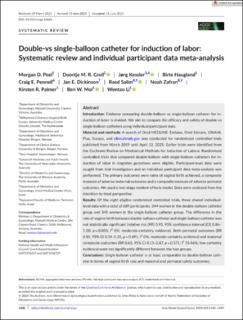| dc.description.abstract | Introduction
Evidence comparing double-balloon vs single-balloon catheter for induction of labor is divided. We aim to compare the efficacy and safety of double-vs single-balloon catheters using individual participant data.
Material and methods
A search of Ovid MEDLINE, Embase, Ovid Emcare, CINAHL Plus, Scopus, and clinicaltrials.gov was conducted for randomized controlled trials published from March 2019 until April 13, 2021. Earlier trials were identified from the Cochrane Review on Mechanical Methods for Induction of Labour. Randomized controlled trials that compared double-balloon with single-balloon catheters for induction of labor in singleton gestations were eligible. Participant-level data were sought from trial investigators and an individual participant data meta-analysis was performed. The primary outcomes were rates of vaginal birth achieved, a composite measure of adverse maternal outcomes and a composite measure of adverse perinatal outcomes. We used a two-stage random-effects model. Data were analyzed from the intention-to-treat perspective.
Results
Of the eight eligible randomized controlled trials, three shared individual-level data with a total of 689 participants, 344 women in the double-balloon catheter group and 345 women in the single-balloon catheter group. The difference in the rate of vaginal birth between double-balloon catheter and single-balloon catheter was not statistically significant (relative risk [RR] 0.93, 95% confidence interval [CI] 0.86–1.00, p = 0.050; I2 0%; moderate-certainty evidence). Both perinatal outcomes (RR 0.81, 95% CI 0.54–1.21, p = 0.691; I2 0%; moderate-certainty evidence) and maternal composite outcomes (RR 0.65, 95% CI 0.15–2.87, p = 0.571; I2 55.46%; low-certainty evidence) were not significantly different between the two groups.
Conclusions
Single-balloon catheter is at least comparable to double-balloon catheter in terms of vaginal birth rate and maternal and perinatal safety outcomes. | en_US |

